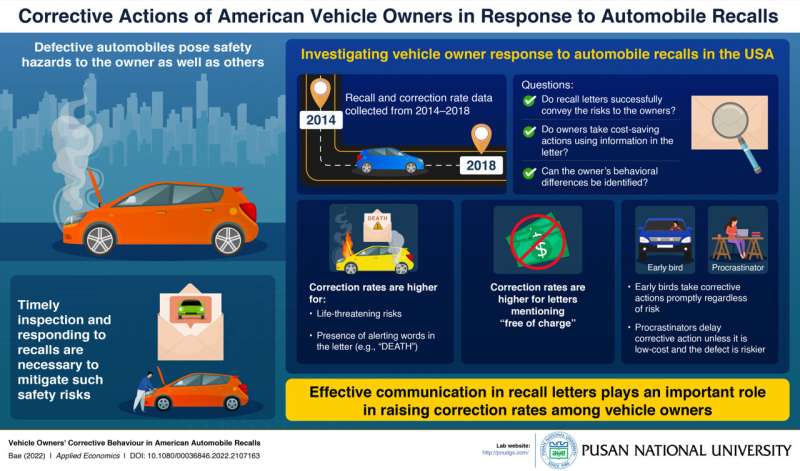
Automobile recalls for manufacturing defects are essential to minimize potential risks and enhance public safety. In the event of a recall, the manufacturer issues a recall letter to the vehicle owner, which communicates the details of the risk involved and subsequent corrective actions. However, it is not clear whether recall letters result in prompt corrective actions.
This motivated Prof. Yong-Kyun Bae from Pusan National University in Korea to investigate corrective behavior among American vehicle owners in response to automobile recalls. “Consumers always face potential risks from defective products. Without proper treatment and preventive tools via product recalls, they cannot be free from unreasonable risks and accidental harm,” notes Prof. Bae.
In a recent study published in Applied Economics, Dr. Bae evaluated the key factors that determine the correction rate, given by the ratio of the number of automobiles inspected and remedied to the total number of vehicles involved in the recall, among American vehicle owners.
To do this, recall data for automobiles in the US were collected for the period 2014—2018 and the following three questions were investigated: Do recall letters successfully convey the risk of defects to vehicle owners? Do vehicle owners opt for cost-saving actions based on the information in the letter? Do they exhibit any behavioral differences in their attitude toward corrective actions?
The analyses underscored the effectiveness of owner notification letters in two scenarios. First, when the recall letter included some alerting words indicating potentially life-threatening risks, such as death, the correction rate was higher. Second, more vehicle owners took prompt corrective measures when the letter emphasized that the corrective procedure was “free of charge.”
“The results showed that vehicle owners responded to riskier defects more actively. Therefore, effective transmission of recall information from manufacturers to vehicle owners is necessary to remove defective vehicles and improve public safety,” says Prof. Bae.
In addition to highlighting the need for effective, standardized communication in recall letters, the study answered the question on behavioral differences among owners by classifying vehicle owners into two broad categories. On one hand were the “procrastinators,” who only take corrective actions in cases of high-risk defects and inexpensive corrective procedures.
On the other hand were the “early birds,” who took prompt action upon intimation, regardless of the severity of the defect. To improve the correction rate, the study recommends that the National Highway Traffic Safety Administration (NHTSA) enforce corrective actions on procrastinators.
Overall, the findings of this study significantly adds to our understanding of human behavior in relation to concern for personal safety. This could greatly benefit manufacturers and regulators in ensuring effective communication with appropriate alert messages in recall letters. “With effective recall regulations, consumers can lead safer lives by consuming safer goods and services. Consequently, it would improve society’s overall welfare to benefit all its members,” concludes Prof. Bae.
US rolls out free app for alerts on vehicle recalls
Yong-Kyun Bae, Vehicle Owners’ Corrective Behaviour in American Automobile Recalls, Applied Economics (2022). DOI: 10.1080/00036846.2022.2107163
Provided by
Pusan National University
Citation:
Effective communication in automobile recalls encourages corrective action among drivers (2022, October 17)
retrieved 17 October 2022
from https://techxplore.com/news/2022-10-effective-automobile-recalls-action-drivers.html
This document is subject to copyright. Apart from any fair dealing for the purpose of private study or research, no
part may be reproduced without the written permission. The content is provided for information purposes only.
Stay connected with us on social media platform for instant update click here to join our Twitter, & Facebook
We are now on Telegram. Click here to join our channel (@TechiUpdate) and stay updated with the latest Technology headlines.
For all the latest Technology News Click Here
For the latest news and updates, follow us on Google News.
